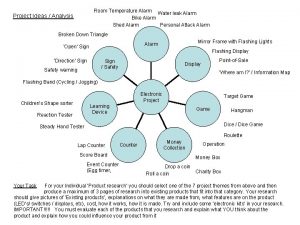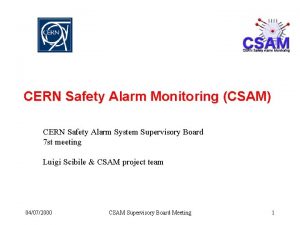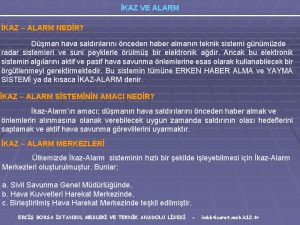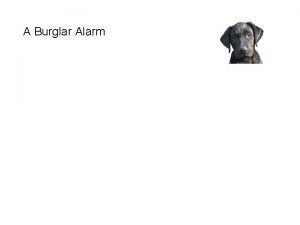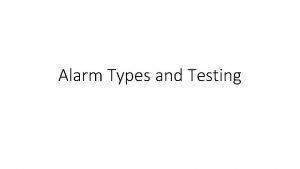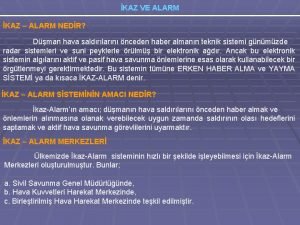Monitoring with the Vision Alarms Alarm Overview Alarm





























- Slides: 29

Monitoring with the Vision Alarms

Alarm Overview ØAlarm: Warning Signal of an Event ØEvent: A Noteworthy Happening • An abnormal clinical occurrence • Requiring clinical awareness or action

Alarm Overview ØEvents Are Related To: • Technical performance of the ventilator system or • Patient’s clinical condition

Alarm Overview Two Types of Alarms ØSystem ØAdjustable

Alarm Overview ØAlarm Indications • Visual • Audible • Two Tones ØAlarm Reset • Manual • Self-canceling ØNurse Call/Remote

System Alarms ØCheck Ventilator Performance ØPreset and Not Adjustable ØContinuous Tone

System Alarms ØVentilator Inoperative ØCheck Ventilator ØPressure Regulation ØProximal Pressure Line ØO 2 Flow ØExhalation Port ØDisconnect

Ventilator Inoperative System Alarm Audible & Visual Why? • System Malfunction • AC Power Failure What Happens? • Ventilator Powers Down • Valves Open to Atmosphere ü allows spontaneous breathing

Check Ventilator System Alarm Audible & Visual Manual Reset ØAbnormal Operating Condition What Happens? • • • Ventilator Continues to Operate Unit Requires Service Visual Indicator Remains Until Condition Corrected

Check Ventilator System Alarm Visual & Audible Manual Reset Why? • Internal Battery Voltage is Low What Happens? Error Code 205 • Internal Battery Cannot Sustain Audible Alarm • AC Power Will Trickle Charge

Pressure Regulation System Alarm Audible & Visual Self-canceling Why? • Proximal and Set Pressure Vary ü +/- 5 cm H 2 O What Happens? P Regulation • Ventilator Sends Available Flow to Achieve Set Pressure

Proximal Line Disconnect System Audible & Visual Self-canceling Why? • Proximal Pressure < 1 cm. H 2 O What Happens? Prox. Line Disc • Ventilator Continues to Deliver Set Pressure

Oxygen Flow System Alarm Audible & Visual Manual Reset Why? • Insufficient Oxygen Flow What Happens? O 2 Flow • FIO 2 Cannot be Maintained Ventilator Continues to Deliver Set Pressure

Exhalation Port System Alarm Audible & Visual Self-Canceling Why? • Baseline Flow Decreases Below Intentional Leak Rate ü 5 L/min or 50% What Happens? Exh Port – Ventilator Continues to Deliver Set Pressure

Learn Function ØLearns Base Flow • Upon system start-up • After mode changes • Activated manually ØWith circuit condition changes ØModify Alarms screen

Disconnect Alarm System Alarm Audible & Visual Self-Canceling Why? • Patient Disconnect ü High flow rates for 4 seconds What Happens? Disconnect • Ventilator decreases flow to idle

Flow Limit Control What Is It ? • Recognizes Patient Disconnection ü Decreases total flow to idle • Flow Returns to Normal ü Spontaneous patient trigger

Benefits of System Alarms ØMonitor Operating Specifications ØWarn of Abnormal Operating Conditions ØVisual Messages Facilitate Troubleshooting

Adjustable Alarms ØMonitor Specific Patient Parameters ØClinician Adjustable ØMultiple Tone

Adjustable Alarms ØHigh Pressure ØLow Pressure • Low Pressure Delay ØApnea ØLow Rate ØHigh Rate ØLow Minute Ventilation

High Pressure Adjustable Alarm Audible & Visual Self-canceling Why? • Proximal Pressure Exceeds Hi P Alarm Limit • What Happens? Inspiration is Terminated MSafety Feature Hi P

Low Pressure & Low Pressure Delay Adjustable Alarm Audible & Visual Self-canceling Why? • Proximal Pressure Below Lo P • Limit for Set Time Delay What Happens? • Ventilator Continues to Function Lo P

Setting Pressure Alarms ØHi P and Lo P • Bracket IPAP ØLo P Delay ØAccording to patient condition

Adjustable Alarm Audible & Visual Self-canceling Apnea Why? • Absence of Spontaneous Trigger for Set Time Interval What Happens? • Timed Breaths are Delivered at Set Rate Apnea

Apnea (con’t) ØAudible resets only when condition is corrected • Two spontaneous triggers MSafety feature ØApnea Can be Disabled

Low Rate Adjustable Alarm Audible & Visual Self-canceling Why? • Total Respiratory Rate is Below Lo Rate Limit Setting Lo Rate Alarm Limits • Set Below Total Respiratory Rate • And Above Set Rate

High Rate Adjustable Alarm Audible & Visual Self-canceling Why? • Total Respiratory Rate is Above Hi Rate Limit Setting Hi Rate Alarm Limits • Set Above Total Respiratory Rate

Low Minute Ventilation Adjustable Alarm Audible & Visual Self-canceling Why? • Minute Ventilation Falls Below Set Lo Min. Vent Limit Setting Lo Min. Vent alarm limits • Set ~ 20% < Total Minute Ventilation ü Use Min. Vent estimation

Benefits of Adjustable Alarms ØMonitor Patient Conditions ØWarn of Critical Changes in the Patient Pas determined by the clinician ØVisual Messages Facilitate Troubleshooting
 Vision alarms
Vision alarms Fire alarms olive branch
Fire alarms olive branch Human vision vs computer vision
Human vision vs computer vision Khi nào hổ mẹ dạy hổ con săn mồi
Khi nào hổ mẹ dạy hổ con săn mồi Các châu lục và đại dương trên thế giới
Các châu lục và đại dương trên thế giới Dạng đột biến một nhiễm là
Dạng đột biến một nhiễm là Nguyên nhân của sự mỏi cơ sinh 8
Nguyên nhân của sự mỏi cơ sinh 8 Bổ thể
Bổ thể độ dài liên kết
độ dài liên kết Thiếu nhi thế giới liên hoan
Thiếu nhi thế giới liên hoan điện thế nghỉ
điện thế nghỉ Vẽ hình chiếu vuông góc của vật thể sau
Vẽ hình chiếu vuông góc của vật thể sau Alleluia hat len nguoi oi
Alleluia hat len nguoi oi Một số thể thơ truyền thống
Một số thể thơ truyền thống Sơ đồ cơ thể người
Sơ đồ cơ thể người Công thức tiính động năng
Công thức tiính động năng Các số nguyên tố là gì
Các số nguyên tố là gì đặc điểm cơ thể của người tối cổ
đặc điểm cơ thể của người tối cổ Tỉ lệ cơ thể trẻ em
Tỉ lệ cơ thể trẻ em Các châu lục và đại dương trên thế giới
Các châu lục và đại dương trên thế giới ưu thế lai là gì
ưu thế lai là gì Môn thể thao bắt đầu bằng từ đua
Môn thể thao bắt đầu bằng từ đua Tư thế ngồi viết
Tư thế ngồi viết Thẻ vin
Thẻ vin Hát kết hợp bộ gõ cơ thể
Hát kết hợp bộ gõ cơ thể Cái miệng nó xinh thế
Cái miệng nó xinh thế Mật thư anh em như thể tay chân
Mật thư anh em như thể tay chân Từ ngữ thể hiện lòng nhân hậu
Từ ngữ thể hiện lòng nhân hậu Trời xanh đây là của chúng ta thể thơ
Trời xanh đây là của chúng ta thể thơ Tư thế ngồi viết
Tư thế ngồi viết






























